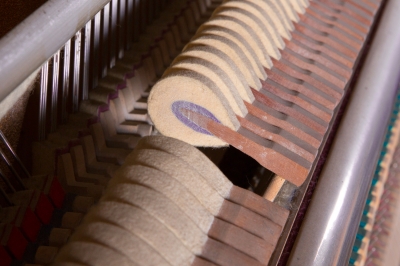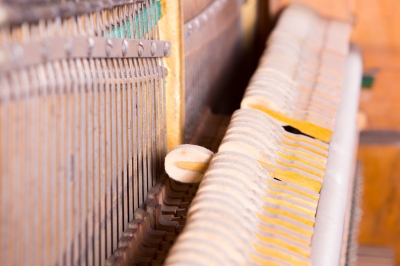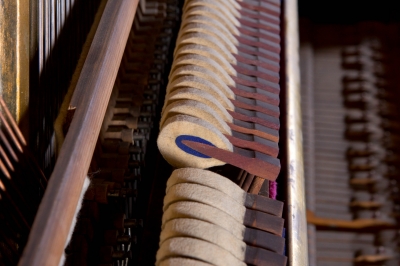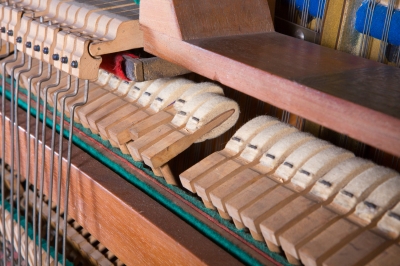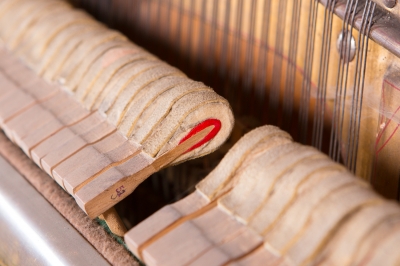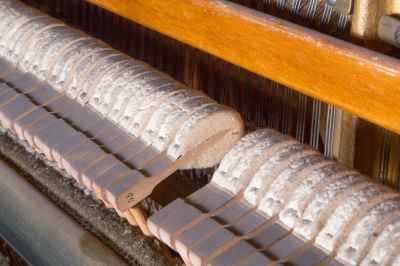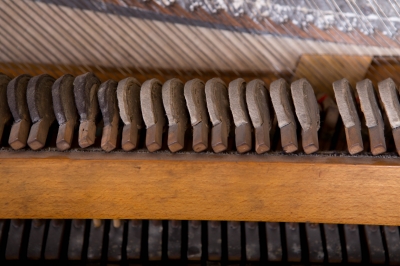Gravicembalo col piano e forte
Clavichords and harpsichords reigned long among musical instruments in spite of their many technical imperfections. They simply had much more advantages. Moreover, there was no better music tool among keyboard chordophones. The clavichord, with its light metal tangents striking the strings, made it possible to control two basic components of the sound, besides the pitch: loudness and timbre. All of it thanks to a close contact between a musician and the element of action (a tangent stiffly connected with a key lever) that strikes directly a string. On the other hand, small size of the whole instrument limited his general audibility and therefore it was used mainly as a home practice instrument. The much larger and louder harpsichord was mainly a concert instrument, owing its better audibility to another way of inducing the string’s vibration. i.e. through plucking. A jack was thrown up by the key lever’s end at which point a quill protruding from the jack plucked the string. The jack had no direct contact with the key lever the moment it was plucking the string. Thus, the possibility to differentiate the dynamic, depending on weaker or stronger striking of the key, was practically minimal. Adding one or two more keyboards, a few sets of strings and rows of jacks with different sets of plectrums did not help. The possibility of fluently changing the dynamic and timbre was still lacking. The sound mechanism’s development helped only to achieve the so-called ‘terrace dynamic’ (a few fixed dynamic levels changing stepwise).
Constructors aimed at building an instrument that could bring together the clavichord’s and harpsichord’s good qualities and be free of their imperfections. Attempts to build such an instrument were noted as early as in the 15th century. An efficient solution was found at the turn of the 17th and 18th centuries. The principle of this new instrument's construction was that the string was struck like in the clavichord and vibrated like in the harpsichord. In the clavichord, the tangent struck the string and continued to touch it all the time it was sounding, as it also divided the string into appropriate sections. Only the section to the right from the tangent vibrated, while the part to the left was damped. In the new construction, a hammer replacing the tangent rebounded from the string, allowing it to vibrate as a whole, with the length being adequately selected to obtain the needed pitch. A string longer and heavier than a clavichord one gave a louder sound, and striking it made it possible to gradually differentiate the sound’s intensity and timbre, depending on the power with which the key was pressed.
Italian intellectual Scipione Maffei saw four such instruments in 1709 at the workshop of Bartolomeo Cristofori, a court harpsichord maker in Florence. Three of them had a wing shape and the fourth had a simpler, yet unspecified, form. According to his account, the new constructions made it possible to change the dynamic fluently when playing, which created new performing options. The inventor called its instrument gravicembalo col piano a forte, i.e. a harpsichord with a possibility to play soft and loud. Still, Cristofori’s new instruments were not equal in loudness to harpsichords. Therefore, Maffei recommended them as suitable for solo or chamber music. Certainly, 1709 cannot be considered the piano’s birth date, as Cristofori had been constructing it for a few years at least and the idea itself must have arisen even earlier. Already in 1700, an arpicimbalo di Bartolomeo Cristofori, di nuova inventione, che fa il piano e il forte (a harpsichord newly invented by Bartolomeo Cristofori which plays both soft and loud) was listed in the Medici instruments’ inventory, and we can assume that this was the date of birth of today’s piano.[i]
Differences between an action drawing from 1709 and the actions of his surviving pianos from 1720 and 1726 prove that the builder had been developing the instrument for the rest of his life. Cristofori’s actions contain most elements of the much more perfect action of today’s piano, such as an intermediate lever, a jack with an escapement, a back-check, a damping system (adaptation of the harpsichord’s jacks) and more. Making it possible to shift the action, the genius constructor even applied the una corda stop. Except for the hammer action, Cristofori’s grand pianos were not much different from harpsichords in construction. Three of his pianos have survived to our days: one dates from 1720 and is kept at the Metropolitan Museum of Art, New York; the second was built in 1722 and can be found at Museo Nazionale degli strumenti musicali, Rome; while the third was made in 1726 (opus 20) and is now stored at the Musikinstrumenten-Museum of Leipzig University. The Conservatorio Luigi Cherubini in Florence possesses his action from c. 1725 (formerly kept in a private collection in Vancouver).[ii]
The Florentine inventor had two competitors for the name of the new instrument’s creator. In 1716, Jean Marius submitted four models of his clavecins à maillets (hammer harpsichords) to the French Royal Academy of Science, including a down-striking action and an action for an upright instrument. They were all very simple and never found any practical application. In 1747, German organist Christoph Gottlieb Schröter declared in public that in 1717 he had outlined two models of a piano action, including a down-striking one, which he had presented at the Dresden court in 1721. Thus far, no direct evidence to prove his claim has been found. Marius’s and Schröter’s down-striking actions (strings struck downwards, in the soundboard’s direction) were inspired by the then popular extended dulcimer, invented and played by violinist Pantaleon Hebenstreit. (In 1705 Louis XIV named the instrument Pantaleon in honor of its inventor.) Hebenstreit’s dulcimer (from the 1720s with a removable hammer action and keyboard, called Hämmerwercke or Hämmerpantalone, used till the 1750s) gave the innovators inspiration not only to have hammers strike the strings but to apply undamped strings as well. It made it possible for the other, unstruck strings of the natural frequencies to harmonize as a resonance (as in the dulcimer). Therefore, Hebenstreit had called himself the inventor of the piano for a long time. The dulcimer also inspired the construction of the damper stop (probably by Gottfried Silbermann between 1725 and 1730).[iii] Some early piano-type instruments, called pantaleons, usually had bare hammer heads or ones covered with only one thin layer of leather. As they did not have any dampers, they could sound like a dulcimer.[iv] In 1739 Schröter also designed another type of piano action, called tangent action, which was then used throughout the 18th century. It derives from the clavichord action but here the tangent-hammer is not connected to the key lever’s end that throws it up.
Though the inventor of the first pianos was Italian, and the composer of the first piano pieces was his compatriot, Lodovico Giustini di Pistoia (Sonate da cimbalo di piano e forte, detto volgarmente di martelletti, which translates as Sonatas for harpsichord with soft and loud, ordinary called a hammered harpsichord, Florence 1732), Italy soon forgot those instruments. Domestic music lovers were fascinated with beautiful singing, masterly violin and harpsichord playing, the latter being a much more technically developed instrument then. Cristofori had a few pupils (int. al. Geronimo of Florence, Gherardi of Padua, Giovanni Ferrini) that made pianos only occasionally on a special order, for example Ferrini for the Spanish queen Elizabeth Farnese. A few other made pianos occasionally in the late 18th century but they did not draw on Cristofori’s model.[v] His influence was visible in the Iberian Peninsula, where piano-making developed in the 18th century through local Spanish and Portuguese builders (maybe with some of Cristofori’s pupils among them).[vi] Unfortunately, they did not have any significant influence on the piano development in the rest of Europe.
In France, the first pianos were brought from England only in the second half of the 18th century. Also, instruments with an additional piano action appeared, such as Weltman’s harpsichord (Paris? 1759).[vii] Further development of the new instrument was started in Germany although Schröter’s inventions, loudly advertised later, did not have a major influence on this process. Scipione Maffei described his visit at Cristofori’s workshop in Giornale dei Letterati d’Italia, vol. V, Venice 1711. He included the drawing of the piano action as well. A translation of the article with the drawing was published in 1725 in Germany.[viii] It is also possible that some of Cristofori’s pupils found employment on the German soil. This way or another, pianos with an action copied after the Florentine instrument, implying a modified mechanism, or even a completely new idea began to be made there.
The earliest ones were made by Silbermanns. The first pianos of the famous organ-builder Gottfried Silbermann from Freiberg did not get Johann Sebastian Bach’s approval. Only about 1745, his fifteen instruments were recognized by the old master, and consequently were bought by Frederick the Great for the Potsdam Palace. Johann Andreas Silbermann of Strasbourg, Gottfried’s older brother, is acknowledged as the author of the prototype of the old-German action (Prellmechanik, later Viennese action). It is derived from the clavichord action, yet here the stationary tangent is replaced by a moving hammer that is still bound with the key lever. A kind of fork (flange, Kapsel), holding the hammer’s axle, connected the two together. When pressed, the key lever went up while the hammer shank’s tail was blocked, which flipped the hammerhead to the string. Usually, the hammerheads of the old-German and Viennese actions were pointed towards the keyboard (unlike in Cristofori’s instruments and their derivatives). Then, Andreas’ son Johann Heinrich Silbermann made actions very similar to Cristofori’s, sometimes their copies. Elements of Cristofori’s actions can be found in German upright pianos of those days, int. al. in pyramids of Christian Ernst Friederici of Gera. The Silbermanns trained a whole array of remarkable pupils, among them Friederici, Johann Andreas Stein and others.
On the German soil, the piano began to be transformed not only in its mechanical part then. Alongside the grand form, still almost a copy of a harpsichord’s, square and vertical forms were developed. The first vertical pianos imitated the clavicytherium. Also here credit should be given to the Italians. At the Instrument Collection of the Luigi Cherubini Conservatory of Music in Florence there is a vertical piano built in 1739 by Domenico del Mela of Gagliano.[ix] Admittedly, the Musikinstrumenten-Museum of Leipzig University posses a vertical piano from 1735 but its origin is not known and the date of making is doubtful. The oldest German vertical pianos had been made from c. 1740 by Friederici’s workshop. Their cases narrowed upwards and thus they were called pyramids. In a pyramid of 1745, Friederici used oblique stringing for the first time.[x] The pyramids’ compass did not exceed four-and-a-half octaves those days.
In Germany, the most popular piano form was the square (rectangular) piano, an adaptation of the clavichord, at least equally popular there. During the first dozens of years, the only difference was applying a hammer action, most often of an old-German or tangent type. Cheapness and small size soon made the square piano the most widespread house instrument. The invention had been long attributed to German builders, which is now legitimately questioned and the credit is given to the British makers.[xi] The keyboard compass of square pianos did not exceed four-and-a-half octaves those days. Small square pianos in the form of polygonal spinets were made as well. At that period, the German grand piano did not stray from Cristofori’s prototype. For example, Gottfried Silbermann applied the Florentine’s modified hammer action, similar stringing and a harpsichord case. Unlike Cristofori, he preserved the harpsichord’s resonance holes. The grand piano’s keyboard compass during the first half of the 18th century was from four to about five octaves. For the time being, the grand piano played the secondary role in the musical life because of its technical imperfections, while the square and vertical types, for practical reasons, had already gained popularity as instruments for home use.
Until c. 1760, the piano was treated as a replacement instrument in the absence of a harpsichord or clavichord, and merely as an instrument for home use. Concerts in public were still performed only with the harpsichord. The new musical tool had been underestimated for a long time because of many reasons. First, it was technically still very imperfect comparing to the harpsichord, which outclassed the piano in sound volume and in action’s efficiency. Due to an almost identical case construction, stringing, and strings type, it did not differ much in sound from the harpsichord. An imperfect action did not allow for a rapid succession of the produced sounds. Light hammers, covered with fabric, parchment, cork, or thin leather, produced a much weaker sound than strings plucked by the harpsichord’s quills. Hardly any of the performers, especially as they were harpsichord players, could appreciate the piano’s genuine assets, such as the possibility of changing the dynamic and the sound tone fluently. They played it as the harpsichord, not the piano. The new instrument did not even have its own name. It was still called a harpsichord, only a ‘hammered’ one (in Italy: gravicembalo di martelletti, in France: clavecin à maillets, in Germany: Hammerklavier).
Professor Benjamin Vogel
The following four fragments on the invention and development of the piano are based on a chapter from my book: Fortepian polski. Budownictwo fortepianów na ziemiach polskich od poł. XVIII w. do II wojny światowej, [The Polish Piano. Piano Making in Polish Territories from the Second Half of the 18th Century until World War II], published in the series Historia muzyki polskiej [The History of Music in Poland], ed. S. Sutkowski, Sutkowski Edition (Warsaw, 1995); See also: B. Vogel, ‘Fortepian polski – addenda et corrigenda’ [Polish Piano – addenda et corrigenda], Studia Musicologica Stetinensis, ed. K. Rottermund, vol. 2 (2010) pp. 111-53
[i] M. Cole, The Pianoforte in the Classical Era (Oxford 1998, p. 3; S. Pollens, The Early Pianoforte (Cambridge, 1995), p. 45. The date of February 1698, set according to Francesco Mannuci’s diary, has been challenged, as has the authenticity of the Mannuci’s diary itself. Comp.: S. Pollens, ibidem
[ii] P. T. Young, The Look of Music (Vancouver, 1980), p. 172
[iii] R. E. M. Harding, The Piano-Forte: its History Traced to the Great Exhibition of 1851 (Cambridge, 21978), pp.17-8; E. Badura-Skoda, ‘Stringed Keyboard Instruments after 1700: Reconstructions of Lautenwercke and a Hämmerpantalone’, Festa Musicologica: Essays in Honor of George J. Buelow, Festschrift Series No.14 (Pendragon Press: New York, 1996) pp. 271-87
[iv] M. Cole, The Pianoforte in the Classical Era (Oxford, 1998) pp. 144-78
[v] S. Pollens, op. cit., pp. 96-117
[vi] Ibidem, pp. 118-56; M. Cole, op. cit., pp. 14-22
[vii] S. Marcuse, A Survey of Musical Instruments (London, 1975) p. 323
[viii] J. Mattheson, Musikalische Kritik, vol.2 (Hamburg, 1725), p. 340
[ix] S. Marcuse, op. cit., p. 321; D. Mezzatesta, ‘Del Mela Domenico’, Encyclopedia of Keyboards Instruments, vol.1, The Piano, ed. R. Palmieri (New York, 1994), pp. 110-112, Fig. 1-2; S. Pollens, op. cit. 107-117
[x] S. Marcuse, op. cit., p. 327
[xi] The authenticity and dating of the 1742 square piano by Johann Socher of Sonthofen, as well as similar pianos signed by Christian Ernst Friederici of Gera have been harshly criticized. Comp.: S. Pollens, op. cit., s. 202-205; M. Cole, op. cit., s. 69, 144-45

